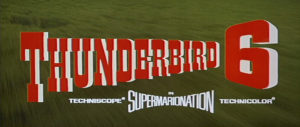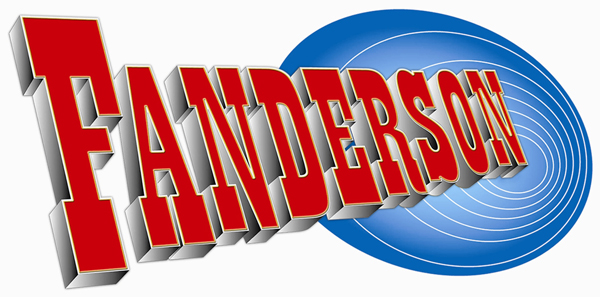
2068: Brains has designed a revolutionary new automated airship, Skyship One, and Penelope, Alan and Tin-Tin will be aboard the craft on its maiden voyage around the world. Alan and Tin-Tin travel by Tiger Moth bi-plane to rendezvous with Lady Penelope and Parker in England and the quartet board the airship, unaware that the entire crew has been gunned down and replaced by imposters.
The bogus crew are in league with The Hood and have bugged every part of the ship that will be used by Penelope in order to record her voice. They plan to rearrange her words to create a false message which will lure Scott and Virgil in Thunderbirds 1 and 2 to a trap at a disused airfield…
Century 21 Cinema/United Artists
Produced: 1967
UK premiere: 29th July 1968
First UK Broadcasts (ITV):
Sunday 25th May 1975 – 11.55am (London Weekend)
Thursday 20th November 1975 – 4.25pm (ATV Midlands)
Saturday 27th December 1975 – 10.25am (Border, Yorkshire and Tyne Tees)
Sunday 28th December 1975 – 11.55am (Southern)
Thursday 26th February 1976 – 4.25pm (Channel and Westward)
Sunday 26th December 1976 – 11.40am (HTV)
Monday 11th April 1977 – 11.00am (Granada)
Monday 28th May 1979 – 11.00am (Anglia)
Tuesday 23rd December 1980 – 10.00am (Grampian)
Friday 17th April 1981 – 10.20am (Scottish)
85 minutes
Executive Producer: Gerry Anderson
Producer: Sylvia Anderson
Associate Producer: John Read
Director: David Lane
Director of Photography: Harry Oakes
Art Director: Bob Bell
Visual Effects Director: Derek Meddings
Music Composed, Arranged and Directed by Barry Gray
Screenplay by Gerry and Sylvia Anderson
Directed by David Lane
Premiere: 29th July 1968 (Odeon Cinema, London)
On Location:
M40, Lane End, High Wycombe, Buckinghamshire
Notes:
Perplexed by the commercial failure of the first Thunderbirds film, Thunderbirds Are Go, United Artists commissioned a second film from Gerry Anderson’s Century 21 Productions, so convinced were they that the concept had the potential for a lucrative long-running series of blockbusters along the lines of their immensely popular James Bond film series. The budget for the new movie, Thunderbird 6, was set at £300,000 with filming to take place alongside Anderson’s new Supermarionation series Captain Scarlet And The Mysterons.
After five months of pre-production work, principal photography on Captain Scarlet began early in 1967, and twelve episodes were in the can before pre-production work on Thunderbird 6 was completed. Since the start of filming on Fireball XL5, the Anderson productions had employed two self-contained camera and puppet crews working simultaneously on separate episodes with duplicated sets and marionettes. In this way, it was possible for principal photography on two half-hour television episodes to be completed in ten days – the equivalent of one episode per week. Captain Scarlet was also filmed in this way until April 1967 when one of the crews was reassigned to Thunderbird 6 – the remaining 20 episodes of the television series were then shot back-to-back with the film over the next five months.
During the preceding year, technical advances in the puppet workshops at the Century 21 Studios in Slough had enabled the further miniaturisation of the circuitry that was installed in the heads of the marionettes to coordinate lip movement with dialogue. As a result, it was now possible to reduce the size of the puppets’ heads to more correct human proportions, so a new style of puppets had been developed for Captain Scarlet, creating a greater effect of ‘realism’ in this and the productions that followed, Joe 90 and The Secret Service. Faced with the choice of retaining the original proportions of the Thunderbirds characters for the feature film, or substituting the ‘anatomically correct’ style puppets, Anderson’s team reached a compromise and new puppets were created for Thunderbird 6 that featured ‘halfway house’ proportions – the heads and hands were still disproportionate to the dimensions of the bodies, but less so than in the Thunderbirds television series and Thunderbirds Are Go.
The original Thunderbirds voice cast was reassembled one last time for a marathon six day recording session. David Holliday, the original voice of Virgil Tracy in the first season of the television series, was now permanently residing in the United States and so, once again, Jeremy Wilkin took the role, just as he had on Thunderbirds Are Go and the six second season television episodes. Unfortunately, there was another casualty in the form of Ray Barrett, who had voiced John Tracy and The Hood for the previous Thunderbirds productions, but had since returned to his native Australia. His roles were taken in Thunderbird 6 by a newcomer, Keith Alexander, who was best-known at the time as the voice of the puppet mouse Topo Gigio. Alexander went on to provide the voice for W.I.N. agent Sam Loover in Joe 90 and B.I.S.H.O.P. agent Blake in The Secret Service. He also appeared in Anderson’s Doppelgänger film and had a regular role as Lt. Keith Ford in UFO.
Location shooting for the film landed the production crew in court when a sequence involving daredevil stunt flying by ace bi-plane pilot Joan Hughes contravened the instructions of on official from the Ministry of Transport. The scene called for Alan Tracy’s Tiger Moth bi-plane to fly under a motorway bridge between junctions 3 and 5 of the M40 (which had just been completed and was not yet open to traffic) near High Wycombe. The Ministry of Transport official insisted that the bi-plane could only pass under the bridge if the wheels were in contact with the road surface, a stipulation that made the stunt significantly more difficult for Joan. Ultimately, a sudden crosswind prevented her from landing the plane and she was forced to fly under the bridge without touching down, or risk losing control of the plane. The Department of Transport prosecuted the crew but the case was thrown out of court. The team was subsequently refused permission to film any more scenes on the M40, so the special effects crew built an entire section of the motorway in miniature on the effects stage to complete the necessary shots. In the finished film, the miniature work was indistinguishable from the material shot on location.
Oddly, although Thunderbird 6 was completed by January 1968 (the date of its British Film Catalogue classification), the film was shelved for six months and eventually received its premiere on the afternoon of 29th July 1968 at the Odeon Cinema, London. This was, perhaps, indicative of United Artists’ loss of faith in Thunderbirds following the termination of the television series and resulting drop in popularity. Like its predecessor, box office returns on Thunderbird 6 were disappointing.
In the intervening years, however, both films have established themselves as cult favourites with repeated cinema screenings showing healthy returns.
| Cast List | |
|---|---|
| Jeff Tracy | Peter Dyneley |
| Scott Tracy | Shane Rimmer |
| Lady Penelope Creighton-Ward | Sylvia Anderson |
| Virgil Tracy | Jeremy Wilkin |
| Alan Tracy | Matt Zimmerman |
| Brains | David Graham |
| Aloysius Parker | David Graham |
| Tin-Tin Kyrano | Christine Finn |
| Gordon Tracy | David Graham |
| John Tracy | Keith Alexander |
| Black Phantom | Gary Files |
| Captain Foster/White Ghost | John Carson |
| N.W.A. President James Glenn | Geoffrey Keen |
| Hogarth | Jeremy Wilkin |
| Lane | Gary Files |
| Carter | Matt Zimmerman |
| Indian Fortune Teller | Christine Finn |
| Narrator | Keith Alexander |
